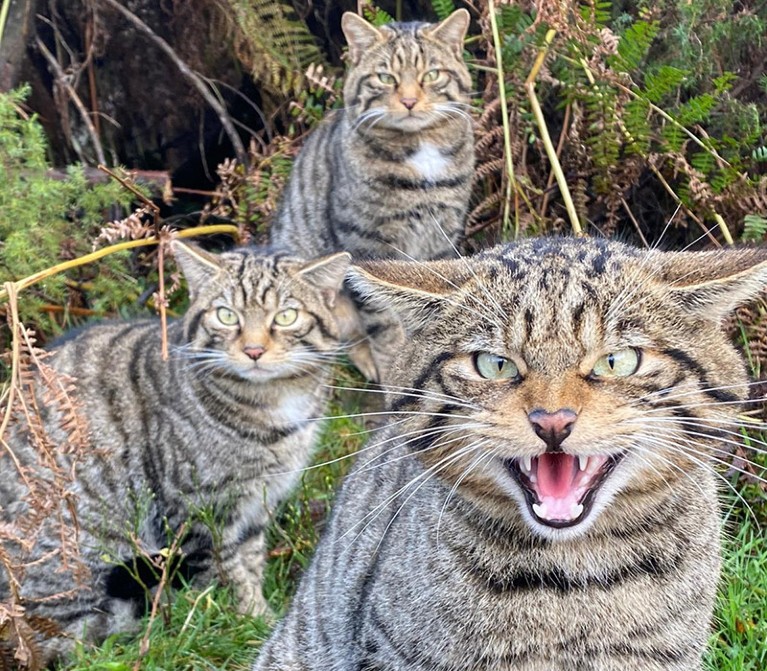Hello Nature readers, would you like to get this Briefing in your inbox free every day? Sign up here.
Scottish wildcats (Felis silvestris) have varying levels of domestic-cat DNA from decades of interbreeding.Credit: RZSS – Saving Wildcats
Plan to breed domestication out of wildcats
Researchers trying to rebuild the Scottish wildcat (Felis silvestris) population are gaining insights from ancient genomics. At a remote wildlife park in the Scottish Highlands, a captive-breeding programme is considering an audacious breeding strategy to eliminate the house-cat DNA that has infiltrated the wildcat genome. To help them to unpick the problem, researchers analysed the genomes of dozens of ancient and modern cats, including the 2,000-year-old remains of a domestic cat found at a Roman palace in West Sussex and those of a wildcat that died 600 years ago, uncovered at a now-ruined castle in the north of England.
Nature | 8 min read
Reference: Current Biology paper & bioRxiv preprint
Source: Ref. 4
Big superconductivity paper retracted
A blockbuster Nature paper describing the discovery of a room-temperature superconductor has been retracted. It is the third high-profile retraction for the two lead authors, physicists Ranga Dias and Ashkan Salamat. Eight of the 11 authors of the paper — including Salamat — had requested that the paper be pulled because it “does not accurately reflect” the nature of the experiment it describes. A separate claim of room-temperature conductivity, made by a start-up company in South Korea in July, also came to nothing — leading some researchers to bemoan the effect on the field’s credibility. “We face a serious communication problem, to make people understand that the field is healthy,” says physicist Lilia Boeri.
Nature | 8 min read
Reference: Nature paper (retracted)
Up to 3% of papers are bogus
Over the past two decades, more than 400,000 research articles have been published that show strong textual similarities to known studies produced by paper mills — and around 70,000 of these were published last year alone. An unpublished analysis shared with Nature estimates that 1.5–2% of all scientific papers published in 2022 closely resemble paper-mill works. Among biology and medicine papers, the rate rises to 3%.
Nature | 6 min read
Features & opinion
Can AI brains illuminate neuroscience?
We’re a ways off from building simulations of entire brains by training machine-learning systems on what we know about what goes on inside our skulls. But there is a hybrid approach that combines information from conventional brain-modelling techniques with machine learning, writes computational scientist Viren Jain, who works on such research at Google. Guided by anatomical and functional data, artificial intelligence (AI)-driven models could be trained to produce simulations that accurately capture what is happening in real biological systems.
Nature | 12 min read
We must study the Twitter cesspit
With the demise of free researcher access to Twitter’s application programming interface, analysing misinformation on the platform is much more difficult — but it must be done, argues digital-literacy researcher Mike Caulfield. A case in point: Caulfield and his colleagues found that a small group of seven dodgy accounts are exercising significant influence on the discourse around the Israel–Hamas war after being boosted by interactions with the platform’s controversial owner, Elon Musk. Although Twitter (now called X, if you must) is used by only a small slice of the population, it is influential — and is now “a ‘natural experiment’ in what happens as a company reduces existing trust, moderation and safety teams”, writes Caulfield.
Nature | 5 min read
How to save birds from the city of glass
Chicago is one of the worst US cities for birds: in October, Audubon published shocking images of almost 1,000 dead birds that had collided with the windows of one building, McCormick Place, in one night. Ornithologist Dave Willard, who has collected birds from McCormick Place since 1978, is among those advocating for bird-safe measures, such as patterned glass. With so many specimens to draw from, Willard’s research has revealed much about migratory birds; for example, they are losing weight and their wings are growing longer as the climate warms. But he’d rather have less data. “We’d trade everything we’ve learned,” he says, “not to have them dead on the sidewalk.”
bioGraphic | 15 min read
reference: Ecology Letters paper
Image of the week

NASA’s Lucy spacecraft has spotted the tiny 790-metre asteroid Dinkinesh’s even tinier companion, about 220 metres wide. Lucy is on a 12-year mission to take a close-up look at Trojan asteroids, which orbit the Sun near Jupiter. “There is no such thing as just another asteroid,” says NASA planetary scientist Thomas Statler. “Each one is carrying with it a memory of a different part of the history of our Solar System.” (The New York Times | 4 min read) (NASA/Goddard/SwRI/Johns Hopkins APL/NOIRLab)
